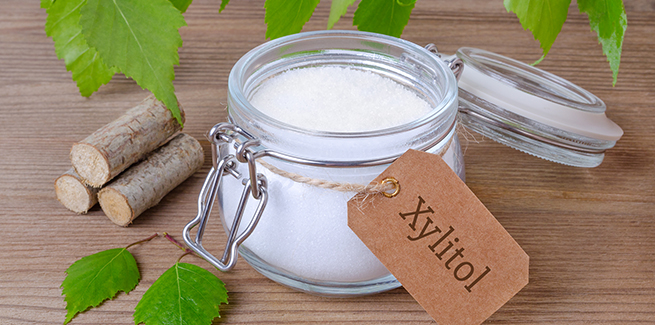Paws off xylitol!

On Tuesday, three members of the US House of Representatives introduced the Paws Off Act of 2021, which would require food products containing xylitol to include a warning label specifying its toxic effects to dogs if ingested.
Xylitol is highly poisonous to pets, especially dogs.
Ingesting xylitol causes a rapid and massive insulin release in dogs. Symptoms include acute weakness, staggering, and vomiting. Within 15 to 20 minutes, they might even be comatose, and can lead to liver failure.
An artificial, plant-based sweetener used in everyday products, xylitol is frequently not listed on the ingredient label, making it difficult for pet owners to keep track of what items are dangerous to their pets.
Cristine Hayes, DVM, medical director of the American Society for the Prevention of Cruelty to Animals (ASPCA) Animal Poison Control Center (APCC) told NEWStat that xylitol poisoning calls have increased dramatically over the last 16 years: The APPC has received more than 6,000 xylitol-related calls so far in 2021, compared to just 201 in all of 2005.
Hayes said the warning label is needed: “Unfortunately xylitol can be found in many commonly purchased goods, and while gum or food items are the most common, you can also find the ingredient in medications, vitamins, and dental health products such as toothpaste.” Xylitol is also used in many baked goods and candy that contain sugar substitutes. “The amount of xylitol found in different products—even different flavors of gum—can vary widely, so it’s important to read ingredient lists on new products and keep any potentially poisonous items out of pets’ reach.”
Hayes said that pets depend on us to protect them from dangerous substances that can harm or kill them, but “Pet owners can’t guard against accidental poisoning when the ingredients or their dangers aren’t listed on products.”
Toxicologist Anna Brutlag, DVM, MS, DABT, DABVT, director of veterinary services and senior veterinary toxicologist for the Pet Poison Helpline (PPH) told NEWStat that PPH applauds the intentions of the proposed bill, but is concerned it may not go far enough: “Currently this proposed legislation only appears to require labeling on food products,” she points out. “We believe that education may be more effective than legislation as we don’t know how practical it would be to require the proposed warning label on every product that contains xylitol.”
Xylitol is sneaky
“I think most veterinarians understand that xylitol can be a problem for dogs,” said Brutlag. “But they may not know that it could be used in nonfood products like baby wipes or face cream, or even personal lubricants. If you’re thinking about xylitol as a sweetener, these are places that you really wouldn’t expect to find it.”
That’s because xylitol isn’t just a sweetener. “It has multiple properties,” Brutlag said. For example, it’s also a humectant and it’s used in products like baby wipes, face cream and, yes, personal lubricants because it helps retain moisture.
A case for xylitol warning labels
Brutlag told NEWStat about Juliet, a 20 pound, 15-year-old Whippet from New York, who ingested an entire 12-piece collection of Godiva dark chocolate truffles. When her owners found the empty package and crumbs, they called PPH.
“At the time of the call to us, Juliet had not developed any clinical signs, but her owners were extremely concerned. We found that this particular Godiva chocolate collection also contained xylitol—it was listed in the package ingredients.”
But, Brutlag said, the package was not marked as sugar-free, as it contained xylitol in addition to sugar. But how much xylitol? The package didn’t say.
Brutlag said that’s why PPH maintains an extensive internal database of xylitol concentrations for many commercial foods and nonfood products: “The amount of xylitol isn’t always declared on food packaging.” PPH staff checked the data and discovered Juliet was facing a toxin double-whammy: “We calculated the amount of xylitol, theobromine, and caffeine that Juliet ingested and determined she was at risk for serious complications from both chocolate and xylitol poisoning.”
At-home decontamination was not possible in Juliet’s case so PPH recommended immediate veterinary referral. Juliet arrived at the clinic stable and with normal vital signs. “We spoke to the clinic staff and created a treatment plan for [her].”
The first step: induce vomiting.
Hospital staff administered apomorphine and Juliet vomited four large piles of chocolate. The good news: “She was asymptomatic and had such good return in her vomit, [so] we speculated her ingestion was fairly recent,” Brutlag said.
Juliet was hospitalized and monitored for signs of chocolate intoxication (vomiting, diarrhea, agitation, tachycardia, arrhythmias, tremors, seizures) and xylitol intoxication (hypoglycemia, hypokalemia, and hepatic necrosis). “In this case, we didn’t hear back from the clinic, which means that her signs did not become severe enough that they needed additional consultation.”
Brutlag said she hopes that Juliet learned an important lesson about eating things she’s not supposed to, “but, knowing dogs, probably not.”
Photo credit © iStock/Getty Images Plus via Getty Images



